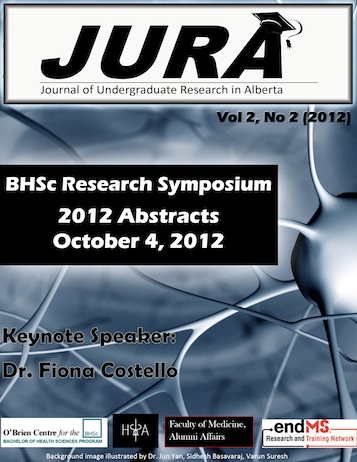Alterations in mTOR Signaling in the Genetic BTBR Mouse Model of Autism Spectrum Disorder
Keywords:
Autism, ASD, Tuberous Sclerosis, mTOR, BTBR, Ketogenic Diet, S6, 4EBP1Abstract
Autism spectrum disorder (ASD) is a neurodevelopmental condition affecting approximately 1% of children in the general population1. Tuberous sclerosis complex (TSC) – a neurocutaneous disorder characterized by multi-system involvement, notably epilepsy – is highly co-morbid with ASD2. Previous studies have suggested that the presence of cortical tubers in the temporal lobe and the early onset of seizures are risk factors for ASD. However, the mechanisms underlying the association between TSC and ASD remain elusive. One potential molecular explanation involves the mTOR signaling pathway3. Disruptions in the mTOR pathway, which have been implicated in studies of TSC, may explain in part susceptibility to and pathogenesis of ASD. The primary purpose of this study was to examine the mTOR signaling pathway in the BTBR T+ tf/J mouse model of ASD4. The ketogenic diet (KD) – a non-pharmacological treatment for medically refractory epilepsy known to down-regulate mTOR signaling – was administered to a group of BTBR mice to evaluate whether it might reverse protein expression changes in the mTOR pathway5. Using western blot analysis, we measured the expression of biomarkers in the mTOR pathway. Phosphorylated mTOR levels were significantly (50%) reduced in BTBR mice, and levels of upstream pAMPK were two-fold higher in these animals compared to B6 controls. BTBR mice showed a significant (40%) reduction in the downstream markers pS6 and p4EBP1. Collectively, the protein levels determined for both upstream and downstream biomarkers were consistent with an overall down-regulation of mTOR signaling. Unexpectedly, the KD did not alter the aberrant expression of mTOR signaling proteins in BTBR mice. Contrary to expectations based on mechanistic speculation, we demonstrated an overall down-regulation of mTOR signaling in autistic BTBR mice. These findings suggest that decreased mTOR activity may be either a cause or consequence of the principal mechanisms underlying the autistic phenotype of BTBR mice.Downloads
Download data is not yet available.
References
1. Centers for Disease Control and Prevention (CDC). (2012). Prevalence of autism spectrum disorders—Autism and Developmental Disabilities Monitoring Network, 14 sites, United States, 2008. MMWR Surveillance Summaries, 61(3):1-19.
2. Curatolo, P., Napolioni, V., and Moavero, R. (2010). Disorders in tuberous sclerosis: Pathogenic pathways and implications for treatment. Journal of Child Neurology, 25:873-880.
3. Zeng, L., Rensing, N. R., and Wong, M. (2009). Developing antiepileptogenic drugs for acquired epilepsy: Targeting the mammalian target of rapamycin (mTOR) pathway. Molecular and Cellular Pharmacology, 1(3):124-129.
4. McFarlane, H. G., Kusek, G. K., Yang, M., Phoenix, J. L., Bolivar, V. J., and Crawley, J. N. (2008). Autism-like behavioral phenotypes in BTBR T+tf/J mice. Genes, Brain and Behavior, 7(2):152-163.
5. McDaniel, S. S., Rensing, N. R., Thio, L. L., Yamada, K. A., and Wong, M. (2011). The ketogenic diet inhibits the mammalian target of rapamycin (mTOR) pathway. Epilepsia, 52(3):e7-e11.
2. Curatolo, P., Napolioni, V., and Moavero, R. (2010). Disorders in tuberous sclerosis: Pathogenic pathways and implications for treatment. Journal of Child Neurology, 25:873-880.
3. Zeng, L., Rensing, N. R., and Wong, M. (2009). Developing antiepileptogenic drugs for acquired epilepsy: Targeting the mammalian target of rapamycin (mTOR) pathway. Molecular and Cellular Pharmacology, 1(3):124-129.
4. McFarlane, H. G., Kusek, G. K., Yang, M., Phoenix, J. L., Bolivar, V. J., and Crawley, J. N. (2008). Autism-like behavioral phenotypes in BTBR T+tf/J mice. Genes, Brain and Behavior, 7(2):152-163.
5. McDaniel, S. S., Rensing, N. R., Thio, L. L., Yamada, K. A., and Wong, M. (2011). The ketogenic diet inhibits the mammalian target of rapamycin (mTOR) pathway. Epilepsia, 52(3):e7-e11.
Downloads
Published
2012-12-05
Issue
Section
Articles
License
Authors retain all rights to their research work. Articles may be submitted to and accepted in other journals subsequent to publishing in JURA. Our only condition is that articles cannot be used in another undergraduate journal. Authors must be aware, however, that professional journals may refuse articles submitted or accepted elsewhere—JURA included.


